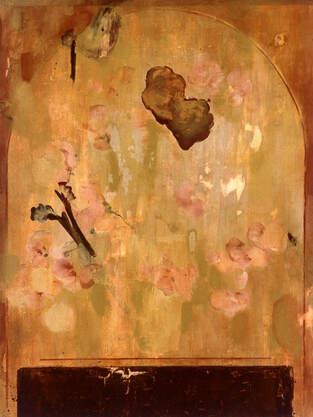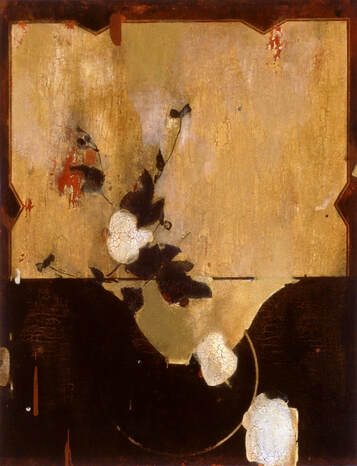Selected Catalog Essays
Bilder über dem Wasser (Pictures over the Water)
Amerika Haus, Berlin
USIS, Bonn, Germany 1991
- Allison Gamble, editor New Art Examiner
|
What do you want to remember?” asked Ben. “A stone,
a leaf, an unfound door. And the forgotten faces.” - Thomas Wolfe, Look Homeward, Angel At a recent after-opening dinner, I overheard one member of the party declare, “I’ve had enough theory,” as he abandoned the huddled, intent looking end of the table. “I just want to look at big, gorgeous paintings.” To which a nearby critic-by-trade nodded silently, emphatically. Over the course of the ‘80s, American painting in particular seemed to become stuck in the decade’s theoretical quagmire--the politics of pleasure. For the most part, the theatrics of the prevailing critical practices of the ‘80s--self conscious irony, pastiche, and the nudge and wink at history--eclipsed those attempts at alternative investigations of aesthetic experience in this previously most privileged medium. Yet, after a decade of death and denial, desire remains. The beauty of Andrew Young’s paintings is that they tap into this desire, demanding sensual engagement in order to further a structural contemplation of that relation between viewer and object. |
Vase and Red, 1989
Egg tempera on wood panel, 30 x 23 in. |
|
Appearance, 1989
Egg tempera on wood panel, 30 x 23 in. |
|
|
The shallow pictorial shelf which the ghosted images of birds, vases, or flowers inhabit the artist has disrupted with small dabs and flat splatters of pigment which float, most decidedly, on the varnished surface. Thus the seemingly random drips, stains, and scars--batterings of time, rescue, and restoration--merge with the (faded?) painterly articulation of abstracted form--the gesture of author and the (un-?) plasticity of the medium--so that the lines between romanticized reflection and formal invention are obscured.
A bird, a vase, a fading flower--delicate, ethereal as the artist has rendered them are but banal decorative images uprooted and reset within arch or architectonic scaffold. Yet, like small fragments from some larger master--the stroke, the whisp, and gouge that denote a stone, a leaf, even an unfound door--blown big, these panels demand an up close and sensual reading. |
Rain and Black, 1992
Egg tempera on wood panel, 23.25 x 18 in. |
|
Untitled (still life), 1989
Egg tempera on wood panel, 30 x 23.5 in. Collection of Illinois State Museum |
What is perhaps so compelling about these works is Young’s ability to index the depth of our intimacy with the purely painterly passage against the shifting stresses on intent and interpretation over history. And he has done so by carefully constructing an axis of airless artifice between viewer and pictorial surface, a space of anxious possibility. To fully read these works--their small defacements and layered perspectives--one must be within arm’s length of them. Compelled to interact with them at a distance that is both respectful and intimate, one is allowed the freedom of rational perspective on the one hand and abandon on the other.
|
|
Over the last three years Young has heightened this tension by slowly closing the gulf, continuously pulling us closer and closer to the surface of the work, collapsing the interior space, and bringing the hard-edged geometrics of frame and molding to the fore. In earlier works such as Vase and Red, Appearance, and Untitled (all from 1989), he balances the purely lyrical flight of color, form, and alchemic gambol against the sacredness of gilt and rose ground, the intensity of iconic stage is less constricted, more open in composition. However, over a relatively short period of time the works have grown increasingly more complex as Young abandoned the traditional ground line in favor of more spatially ambiguous and abstracted compositions.
|
Bureau Chief, 1990
Egg tempera on wood panel, 28 x 23 in. |
|
Sentinel, 1990
Egg tempera on wood panel, 28 x 23 in. |
From the shallow, sepia-shaded reliquary of My Wives to the flattened space and harsher light of its inverted sibling Less Divided Young has traversed centuries. As he has sharpened his focus and play of perspectives in works such as Bureau Chief or Sentinel, so too has he continued to broaden and sharpen the palette to border on acid. In the most recent work (Tigress, not included here) Young has pushed the interplay of formal elements even further, building and gouging a surface in egg tempera that approaches that of encaustic. Patiently paring away at the reliance on mutually recognized systems of allusion and illusionistic referents--the sacred, the beautiful, the recognizable he has pulled us close to see just how much the pictorial surface can bear and still breathe.
|
|
Knowing that meaning is ascribed through a constantly renegotiated series of relations and that access--however one may choose to diagram or demarcate it--has always followed along the lines of intimacy. Andrew Young has created small windows through which we can once again glimpse belief.
- Allison Gamble, editor New Art Examiner |
Tigress, 1991 (diptych)
Egg tempera on wood panel, 23 x 22.5 in. Collection of Tucson Museum of Art |






